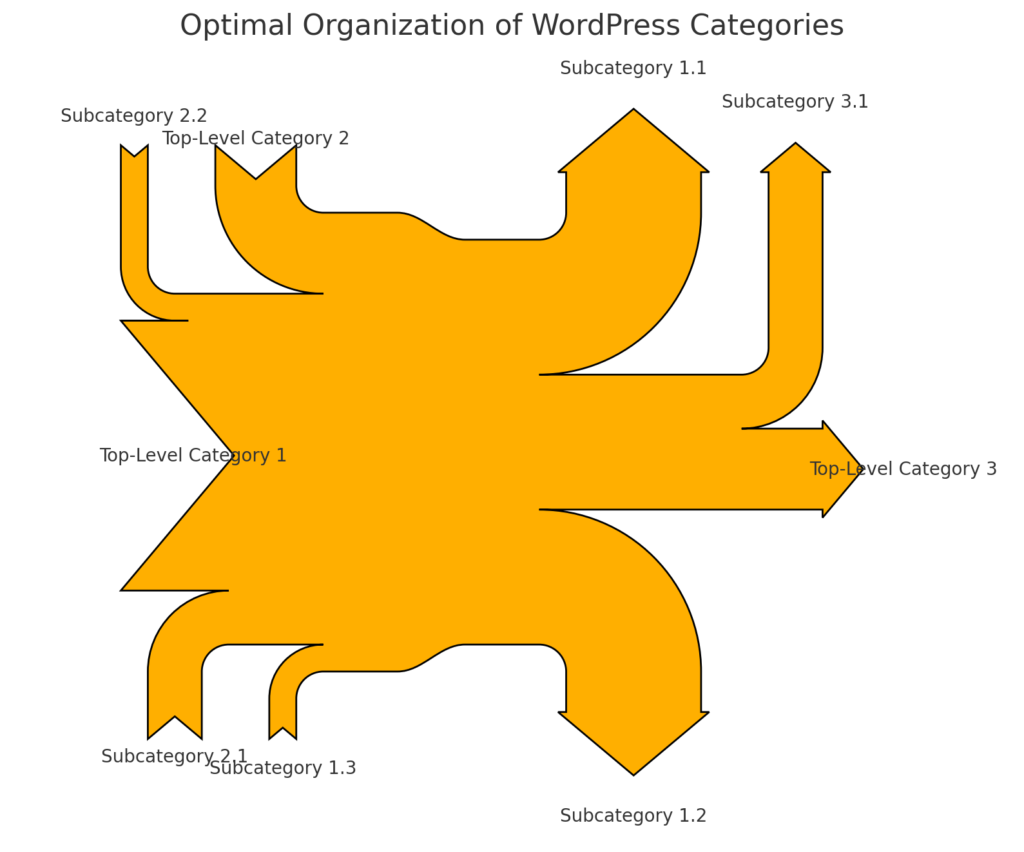Button Call to Action Subscribe
Green Screens Action Background
Optimize WordPress Categories (you are here)
Ready to streamline your website and optimize WordPress post categories? Start implementing these simple strategies today to see the difference in user experience and SEO performance.
Download our graph on effective category organization below and get started!
1. Why You Should Optimize WordPress Post Categories
To organize WordPress post categories, you first need to understand why categorizing is essential. An organized category structure improves user experience, making it easier for visitors to find relevant content. Moreover, boost content in WordPress through effective categorization helps search engines understand your content, potentially improving SEO rankings.
- Improved User Experience: Categories streamline navigation and help users locate the content they need faster.
- SEO Benefits: An optimized category structure signals search engines about the relevance of each post.
- Better Content Organization: A clear category hierarchy supports content management, particularly for large sites.
Optimize WordPress post categories by following simple steps to increase your blog’s engagement and accessibility.
2. How to Organize WordPress Post Categories Efficiently
One effective way to optimize WordPress post categories is by following a consistent and logical structure. Start by listing out main topics relevant to your blog or website. WordPress category management tips suggest keeping the categories broad enough to cover different areas while remaining specific enough to maintain focus.
- List Primary Topics: Write down key themes or topics that define your content.
- Limit Categories: Avoid overloading with too many categories, as it can confuse readers.
- Use Subcategories: For broad topics, use subcategories to add depth and organization.
This logical organization boosts improve WordPress category visibility and enhances the site’s SEO value, helping readers and search engines navigate your content more effectively.
3. Best Practices for Updating WordPress Post Categories
Regularly updating your category structure is a simple way to optimize WordPress post categories. Over time, your content may expand, requiring new or adjusted categories. Make WordPress post visible by aligning categories with evolving topics on your site.
- Review Categories Quarterly: Set aside time each quarter to assess if categories reflect current content.
- Merge Similar Categories: If two categories are too similar, combine them to streamline organization.
- Unassign Unused Categories: Deactivate categories that no longer serve your content strategy.
Following these best practices can lead to a well-structured blog that effectively boosts content in WordPress.
4. Using Tools to Boost Content in WordPress
Many tools are available to help you optimize WordPress post categories efficiently. For instance, plugins like Yoast SEO can help streamline category management, while organize WordPress post categories becomes easier with page builder tools.
- SEO Plugins: Use plugins like Yoast SEO to receive category optimization suggestions.
- Content Management Tools: Some plugins allow you to bulk-edit categories, saving time.
- Analytics: Use analytics tools to track category performance and make adjustments.
Employing these tools allows you to improve WordPress category visibility without manual labor, giving you more time to focus on content creation.
5. How to Keep Your WordPress Categories SEO-Friendly
To optimize WordPress post categories, you must consider SEO-friendly practices. This includes keyword usage, URL structure, and ensuring each category is populated with relevant content. WordPress category management tips recommend using concise, keyword-focused names for each category.
- Keep Names Short: Long category names can dilute SEO value.
- Use Keywords: Incorporate relevant keywords to improve search engine rankings.
- Avoid Empty Categories: Populate each category with at least a few posts for SEO impact.
By maintaining an SEO-friendly approach, you can boost content in WordPress, making it more discoverable through search engines.
6. Ways to Make WordPress Post Visible with Internal Linking
Internal linking is another powerful way to optimize WordPress post categories. Adding internal links between posts within the same category can make WordPress post visible and easily accessible to readers. It’s also beneficial for SEO as it helps search engines crawl your content effectively.
- Link Related Posts: Encourage readers to explore similar posts by linking within the same category.
- Use Anchor Text: Make sure the anchor text is relevant and includes keywords.
- Add a Related Posts Section: This section at the end of each post keeps readers engaged.
Through strategic internal linking, you can improve WordPress category visibility and guide users through a meaningful content journey.
7. The Benefits of WordPress Category Management Tips for Content Growth
Following WordPress category management tips not only organizes content but also sets the stage for growth. A well-managed category structure supports efficient content expansion, allowing you to add new posts seamlessly into your existing framework. Organize WordPress post categories and set your site up for long-term success.
- Scalable Structure: An organized layout accommodates future content easily.
- Enhanced Reader Engagement: A coherent structure invites readers to stay on the site longer.
- Increased Discoverability: Content categorized effectively can reach a wider audience.
By implementing these tips, you’ll find that your website can handle growth while maintaining a clean structure.
SpiritFairie Whispers on Youtube

